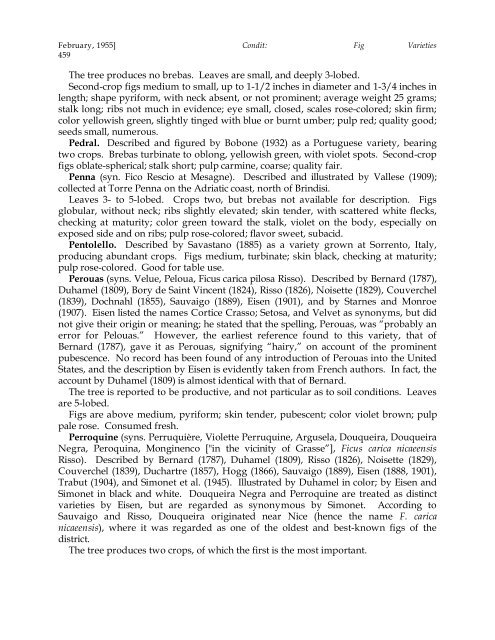Fig Varieties: A Monograph - uri=ucce.ucdavis
Fig Varieties: A Monograph - uri=ucce.ucdavis
Fig Varieties: A Monograph - uri=ucce.ucdavis
You also want an ePaper? Increase the reach of your titles
YUMPU automatically turns print PDFs into web optimized ePapers that Google loves.
February, 1955] Condit: <strong>Fig</strong> <strong>Varieties</strong><br />
459<br />
The tree produces no brebas. Leaves are small, and deeply 3-lobed.<br />
Second-crop figs medium to small, up to 1-1/2 inches in diameter and 1-3/4 inches in<br />
length; shape pyriform, with neck absent, or not prominent; average weight 25 grams;<br />
stalk long; ribs not much in evidence; eye small, closed, scales rose-colored; skin firm;<br />
color yellowish green, slightly tinged with blue or burnt umber; pulp red; quality good;<br />
seeds small, numerous.<br />
Pedral. Described and figured by Bobone (1932) as a Portuguese variety, bearing<br />
two crops. Brebas turbinate to oblong, yellowish green, with violet spots. Second-crop<br />
figs oblate-spherical; stalk short; pulp carmine, coarse; quality fair.<br />
Penna (syn. Fico Rescio at Mesagne). Described and illustrated by Vallese (1909);<br />
collected at Torre Penna on the Adriatic coast, north of Brindisi.<br />
Leaves 3- to 5-lobed. Crops two, but brebas not available for description. <strong>Fig</strong>s<br />
globular, without neck; ribs slightly elevated; skin tender, with scattered white flecks,<br />
checking at maturity; color green toward the stalk, violet on the body, especially on<br />
exposed side and on ribs; pulp rose-colored; flavor sweet, subacid.<br />
Pentolello. Described by Savastano (1885) as a variety grown at Sorrento, Italy,<br />
producing abundant crops. <strong>Fig</strong>s medium, turbinate; skin black, checking at maturity;<br />
pulp rose-colored. Good for table use.<br />
Perouas (syns. Velue, Peloua, Ficus carica pilosa Risso). Described by Bernard (1787),<br />
Duhamel (1809), Bory de Saint Vincent (1824), Risso (1826), Noisette (1829), Couverchel<br />
(1839), Dochnahl (1855), Sauvaigo (1889), Eisen (1901), and by Starnes and Monroe<br />
(1907). Eisen listed the names Cortice Crasso; Setosa, and Velvet as synonyms, but did<br />
not give their origin or meaning; he stated that the spelling, Perouas, was “probably an<br />
error for Pelouas.” However, the earliest reference found to this variety, that of<br />
Bernard (1787), gave it as Perouas, signifying “hairy,” on account of the prominent<br />
pubescence. No record has been found of any introduction of Perouas into the United<br />
States, and the description by Eisen is evidently taken from French authors. In fact, the<br />
account by Duhamel (1809) is almost identical with that of Bernard.<br />
The tree is reported to be productive, and not particular as to soil conditions. Leaves<br />
are 5-lobed.<br />
<strong>Fig</strong>s are above medium, pyriform; skin tender, pubescent; color violet brown; pulp<br />
pale rose. Consumed fresh.<br />
Perroquine (syns. Perruquière, Violette Perruquine, Argusela, Douqueira, Douqueira<br />
Negra, Peroquina, Monginenco ["in the vicinity of Grasse”], Ficus carica nicaeensis<br />
Risso). Described by Bernard (1787), Duhamel (1809), Risso (1826), Noisette (1829),<br />
Couverchel (1839), Duchartre (1857), Hogg (1866), Sauvaigo (1889), Eisen (1888, 1901),<br />
Trabut (1904), and Simonet et al. (1945). Illustrated by Duhamel in color; by Eisen and<br />
Simonet in black and white. Douqueira Negra and Perroquine are treated as distinct<br />
varieties by Eisen, but are regarded as synonymous by Simonet. According to<br />
Sauvaigo and Risso, Douqueira originated near Nice (hence the name F. carica<br />
nicaeensis), where it was regarded as one of the oldest and best-known figs of the<br />
district.<br />
The tree produces two crops, of which the first is the most important.















![Fig Trees in North Carolina [Archive] - IDigMyGarden ... - Figs 4 Fun](https://img.yumpu.com/26905320/1/190x245/fig-trees-in-north-carolina-archive-idigmygarden-figs-4-fun.jpg?quality=85)
